Chris Kridler
Chris Kridler is a writer, photographer and storm chaser and author of the Storm Seekers Series of storm-chasing adventures.
Chris Kridler is a writer, photographer and storm chaser and author of the Storm Seekers Series of storm-chasing adventures.

Just shy of severe weather awareness week, a shelf cloud from an outflow boundary moves over Cocoa, Florida, on Feb. 23, 2014. Tornado warnings were issued farther north. Photo by Chris Kridler, ChrisKridler.com
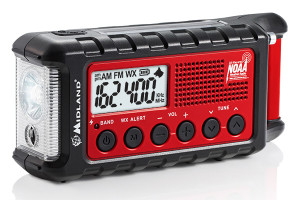
This light, portable weather radio from Midland, the ER300, sounds alerts and has a variety of other functions.
Midland makes several models of weather radio and sent me its ER300 for review. This portable radio’s multiple functionality appeals to my love of gadgets. First, it’s light (just a pound) and fairly small, with a handle, though it won’t fit in most pockets. It’s a natural companion for the beach or any outdoor activity as well as for emergencies.
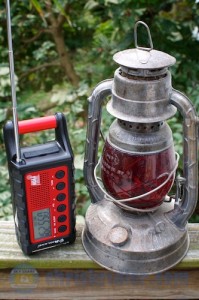
MIdland’s ER300 weather radio is shown with an old railroad lantern for size comparison. Photo by Chris Kridler, ChrisKridler.com
There are more goodies: a built-in LED flashlight with a dim, bright or flashing SOS setting, AM/FM radio in addition to weather radio, a clock display, and an ultrasonic dog whistle. The latter didn’t get a blink from my lazy Cavaliers, but it could theoretically help alert search and rescue dogs in the worst kind of emergency. There’s a headphone jack, too. (Addendum 2/27: I got to hear the weather alert during our state tornado drill, and there’s no way you can miss it! It sounds like a series of incoming torpedoes.)
Once the radio is charged, the USB ports can be used to power your tablet or cell phone — again, a handy feature if your power is out for a while. We could’ve used something like this in the onslaught of 2004 hurricanes, when our electricity was out for days.
I found the push-button controls fairly easy to use, though you’ll want to read at least the quick-start guide. The retractable antenna should be extended for best reception. The radio retails for $79.99. If cost is a concern, you can get a weather radio for a lot less (e.g. Midland’s HH50 Pocket Weather Alert Radio for $24.99). It’s worth it. It can save your life.
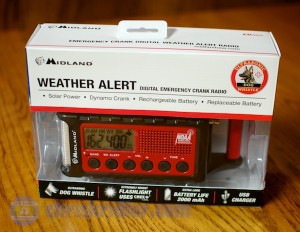
Midland’s ER300 weather radio in the box. Photo by Chris Kridler, ChrisKridler.com
What: ER300 Emergency Crank Weather Alert Radio
Features: Weather radio with alert; AM/FM radio; multiple ways to power it, including crank, solar, USB and AA batteries; LED light/beacon; supersonic dog whistle; clock; headphone jack
In the box: radio with rechargeable battery; USB charging cable; owner’s manual
Retail cost: $79.99
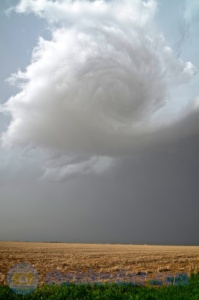
One of my favorite shots of 2013. I call it “Gateway to Infinity,” a reference to a line in my novel “Tornado Pinball.” This rotating updraft was shot May 24 near Holyoke, Colorado. Photo by Chris Kridler, ChrisKridler.com
If the photo in itself is great, it might have been shot from a better angle, at a different time, or on a different storm. Because in storm chasing, the first rule is location, location, location. The second is timing. You can be a technically great photographer (I’m still working on that, too) and never be a great storm photographer if you can’t get into the right place at the right time.
In 2013, I saw a lot of extreme weather, most of it packed into less than three weeks during my annual whirlwind tour of Tornado Alley. Yet I still curse myself for not being in better position on some of the storms I saw and for missing others. Such is always the way of the perfectionist; that drive is a blessing and a curse, since perfection is never possible, except, perhaps, in the sweeping curves of a supercell at sunset. I’ll leave perfection to nature and post my imperfections right here.
I’ve put some of my favorite weather photos of 2013 into a video slide show. Watch it here, or if you like, see the photos themselves.
I’ve been neglecting my blog. I’ve been consumed with several projects, including editing two books – it’s so exciting to work with other writers as an editor. That’s how I started my career in journalism, as a copy editor. It always seemed like something I could do while I wrote other things, and I did, though I eventually became a reporter (and videographer and photographer). I’m also working on the third Storm Seekers novel, Zap Bang.
But in the meantime, I’m scheduling events for 2014. Come see me at the Brevard Museum of History and Natural Science on Jan. 12 at 2 p.m. I’ll be sharing stories, videos and photographs from my 17 years of chasing storms in Tornado Alley and Florida.
Happy holidays, everyone. (Oh, yeah, and if you need a gift or a good read for that new Kindle or tablet, won’t you consider Funnel Vision and Tornado Pinball?)
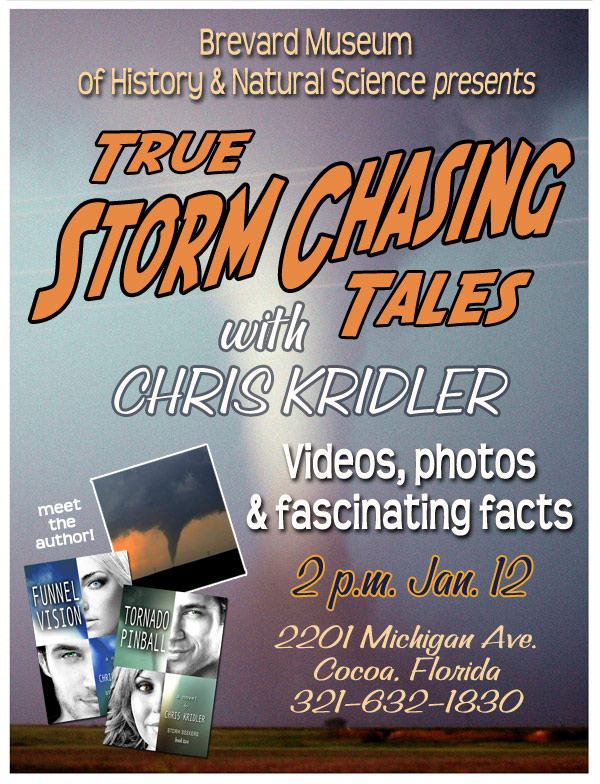
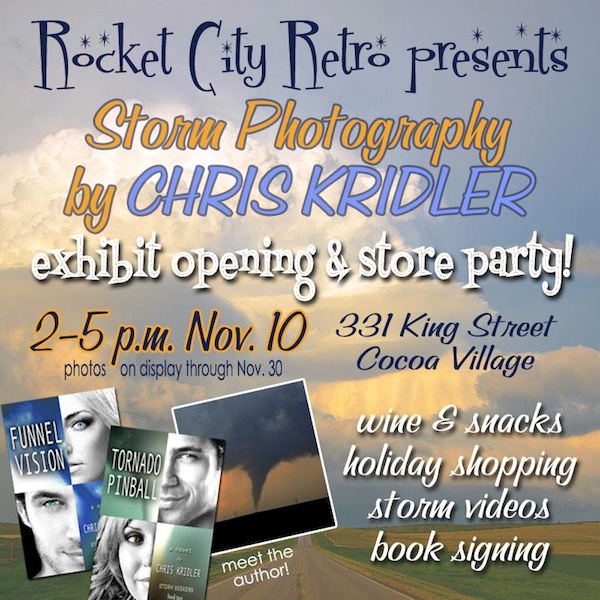
I have several events coming up, and I hope you can join me to talk about storms and books!
On Sunday, Nov. 10, I’ll sign books at a party marking the launch of a new storm photography exhibit. It will include photos from this year’s chaotic storm season. The party is 2-5 p.m. at Rocket City Retro Mid-Century Modern Furniture & Design, 331 King St., in Cocoa Village. The free event will feature wine, hors d’oeuvres and storm videos in addition to photography of tornadoes, lightning and severe weather, displayed amid Rocket City Retro’s stylish furnishings and gifts from the 1950s to the 1970s. My photos will be on display through Nov. 30.
I’ll also be at the Meet the Authors Book Fair Nov. 23-24 at Eau Gallie Civic Center, which happens in conjunction with ArtWorks. I’ll be signing “Funnel Vision” and “Tornado Pinball,” the first two storm-chasing adventures in the Storm Seekers Series.
Also catch my storm photography Dec. 2-31 at the Cocoa Beach Library, 550 N. Brevard Ave. In a free library talk on Dec. 4 at 6:30 p.m., I will discuss what it takes to shoot great storm and lightning photos, drawing on 17 years of experience chasing storms in Tornado Alley and Florida. And I’ll sign books, in case you haven’t picked up yours yet.
See you out there!
This is not a book-review blog, as a rule, but when the folks at Simon & Schuster asked if I’d like to take a peek at Michael Farris Smith’s novel of meteorological calamity, “Rivers,” I couldn’t resist. I’m sure they didn’t ask me because of my brilliant literary insights. I’d guess it’s because I’m a storm chaser and weather geek. But before I talk about the weather, I have to address the story — especially because the storms are really secondary to the characters.
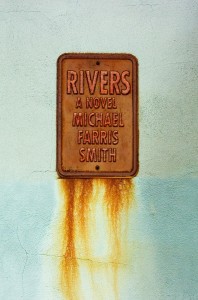
BOOK REVIEW: ‘Rivers’ by Michael Farris Smith (Simon & Schuster, 337 pages, $25)
“Rivers” follows in the steps of Cormac McCarthy’s “The Road,” if incrementally less grim and less spare. In a near future when the United States government has written off the Gulf Coast as a hurricane-blasted wasteland, Cohen is a builder who’s decided to stay behind among the survivalists, the desperate, and the treasure hunters digging for troves of cash they think were buried by the fleeing casinos. We soon find out why: He’s still dealing with a storm-precipitated personal tragedy, and his home is the last vestige of his happy life.
Cohen lives an isolated existence made less lonely by a stray dog and horse and punctuated only by supply runs. But what’s left below The Line is certainly no Walden Pond, no place for quiet contemplation as nature reclaims the land. It’s more like the zombie apocalypse without the zombies. It’s a place of redneck primitivism, woman-enslaving cults and mercenaries who shoot first and ask questions later as one devastating storm after another rakes the tattered lowlands. When a generous impulse jeopardizes Cohen’s bulwarks against the chaos, he’s forced to confront the worst elements of this world and his own demons, choose alliances and try to find his way out.
Smith’s sentences stretch out like Cohen’s dreary days, in a loping, run-on, hypnotic rhythm. The author shifts point of view between characters with a sometimes irritating fluidity. His flashbacks feel more conventional, with more orderly paragraphs that reflect Cohen’s then-contented days at home and on an enchanting vacation in Venice with his wife among the “rivers” there.
Smith writes of one of Cohen’s moments of despair:
The “rivers” on the Gulf Coast seem ever-expanding in this apparent global-warming-caused disaster, though climate change is merely implied by the fact of the storms. The storms themselves seem to be, technically speaking, hurricanes that come every few days, though their behavior is at times unusual for tropical systems (pardon me while the weather geek has her say). Warm-core tropical systems rarely leave people cold or bombard them with massive hailstones. But maybe this crazy weather is beyond our ken as we try to foresee a future that eludes even the climate scientists.
What’s more important in the confines of the novel is that the untamed and relentless storms are reflected in the ragtag, ruthless humans living in their domain, and it will take an extraordinary person to rise above the madness. The plot is almost as unruly as the weather, but in the last fifty pages it presses the accelerator and drives hard to the end.
Will you like “Rivers”? “Like” isn’t really the term one applies to apocalyptic novels, but readers drawn to desperate, poignant survival literature may admire it. If you’re looking for a story about meteorological carnage, “Rivers” is a lot more, and a lot less in the weather department, as the storms only set the stage for the human drama. This isn’t storm porn. And on a personal note, I never like seeing animals in peril, even in a “literary” novel.
That said, I found the novel interesting and ultimately compelling, particularly in its forceful climax. I appreciated that, like the weather, it kept me guessing. Like a brutal storm, “Rivers” will test you — and it might make you think twice about buying waterfront property.

Money isn’t the only yardstick for writing success. Photo by Chris Kridler, ChrisKridler.com
Certainly, selling a lot of books is some measure of success, and since I don’t sell a lot (“yet,” she said hopefully), I haven’t met that bar.
Success could and should also be about writing a great book, whether it’s fiction, poetry or nonfiction. This quality is more difficult to measure, though reviews or a fan following might help convince you that you’ve achieved it.
Lastly, do you like your own book? Writers are a self-critical bunch, or at least the best ones are, and so they may be more likely to beat themselves up over their flaws. If you can see flaws, chances are you have some perspective on your work. And in spite of those flaws, if you still like your work, if it satisfies you at some basic level, then you probably are a success, even if it’s only in your home office.
Those who are simply out to sell books, which is what we are told over and over again we must do as professional writers (professional = paid), seem to take different tracks to achieve their goals. And since (a) I want to write to please myself but (b) I’d also like to sell some books, I’ve been wondering if selling books has to mean, in some sense, selling one’s soul.
I love Pixel of Ink and check out the free e-books it mentions every day. I even download and read some of them. But despite its diverse highlights, sometimes I think I’m reading the same description over and over. I don’t care how hot young-adult fiction is; when the summaries are interchangeable, either there’s an appalling lack of originality, or people are writing to a formula to sell books. They go something like this: “When 16/17/18-year-old Jane discovered she had hidden powers to fly/move stuff/read minds/time travel/talk with fairies, she never counted on learning about them with hunky teenage alien/sorcerer/telepath/angel/vampire Joe, her secret protector. Together they must save the world/fight the totalitarian dystopian government/hide their superpowers while they go to high school.” Hey, I get it. Young people (especially young women) want stuff to read that they can relate to, and we all like a good escape.
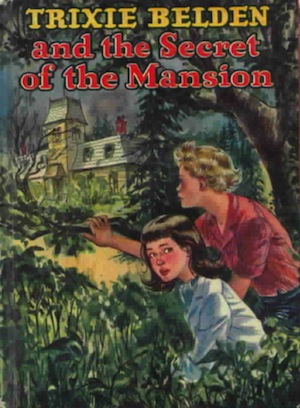
Girl detectives were great early role models. (Image courtesy Wikipedia)
I wonder sometimes if I could write in one of these genres deemed “hot,” maybe under a pen name. Maybe I should sell out, join the crowd – not that there’s a guarantee I’d sell books then, either. And you have a point if you say, no, you should just write a really good book that will sell because it’s really good, no matter what the subject matter; make your own trend. But, let’s face it, books have a leg up when they’re in a marketable genre, and a leap up if they seem to be kind of the same as something else that was already popular. Some literary agents say you shouldn’t write to a trend, because by the time your book is out, the trend may have changed. That advice doesn’t seem to be stopping anyone, and my general impression is that many agents and publishers are fond of proven sellers, not iconoclastic new voices. After all, publishing is a business, and art is its increasingly rare offspring. (Gwen Stephens shares one agent’s perspective on writing to trends here.)
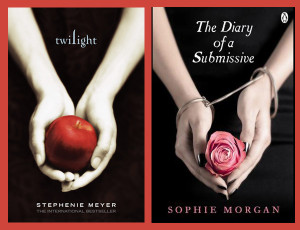
Judging books by their covers – and their genres.
I enjoy well-written genre books. And I might even write a mystery or a romance or a young-adult fantasy someday. But I don’t want to do it just because I think it will sell, especially if the formula involves a passive female creature whose one goal in life is to be noticed by a man. We deserve better as writers and as readers. Success may be elusive on every level, but perhaps we can start by finding it in the obscurity of our home office, writing stories from the heart.
I’ve photographed not-so-great shots of the moon with a thunderstorm before, but nothing like this. Better yet, there were multiple shots, though the lead one shown here is definitely my favorite.
Meanwhile, prints of this photo (and other lightning images) can be ordered here.
Roll over a photo to see its caption, and click on any of the pictures to start a slide show of larger images.
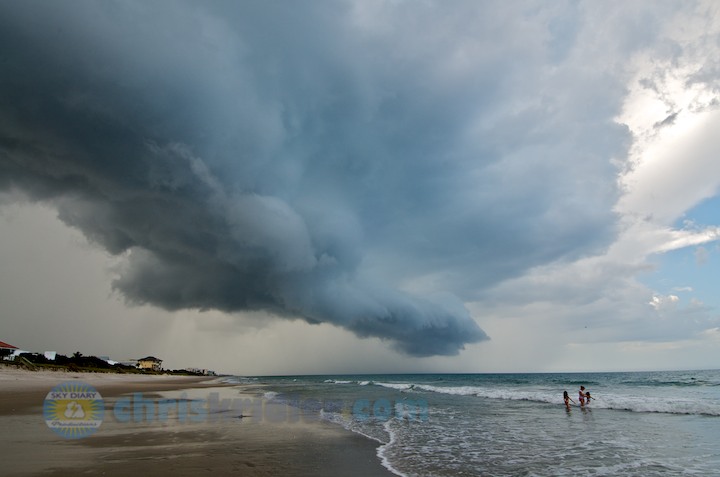
This is where the storm started to get dreamy, though I was somewhat concerned for the waders. Photo by Chris Kridler, ChrisKridler.com
The beaches have been under siege here in Brevard County for the past couple of days as ominous shelf clouds have swept over the sun-worshipers and surfers, harbingers of downpours and lightning close behind. I’ve caught photos in the past couple of days at Cocoa Beach and Satellite Beach. In both places, some folks didn’t seem to be in a hurry to escape the lightning danger, which was high. I take a risk, too, when I stand on the beach to shoot a photo, and I’m well aware of it.
Today’s storm over Satellite Beach was especially beautiful. As dangerous as the lightning might have been, I couldn’t look away. See all the 2013 chase reports here.
Still need a beach read for this summer? My storm-chasing adventures, “Funnel Vision” and “Tornado Pinball,” are just $3.99 as e-books. They’re also in paperback. Check ’em out. (You can quite literally check them out of the Brevard libraries, too.)
Roll over a photo to see its caption, and click on any of the pictures to start a slide show of larger images.
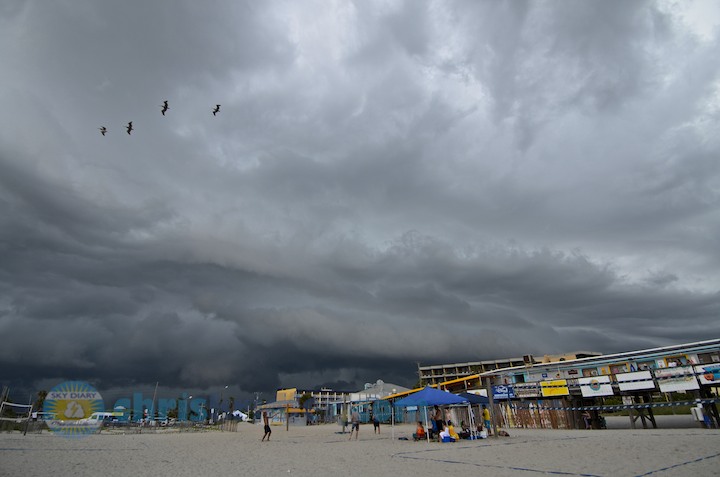
The line approached Cocoa Beach Pier. Photo by Chris Kridler, ChrisKridler.com
Boundary collisions were evident on radar the afternoon of July 21, leading to storms, but I waited until they were well under way and a severe storm warning was issued before I headed out to take a look.
I stayed ahead of a pretty but fragmented shelf cloud from Merritt Island into Cocoa Beach, Florida. Shelf clouds always seem to reach their majestic maturity when they hit the beach.
Roll over a photo to see its caption, and click on any of the pictures to start a slide show of larger images.
I love a nice shelf cloud, and I’ve missed a few of them this season. Florida always has more, though, and I caught one this afternoon as a pretty line of storms rolled through Brevard County.
Storms set up in a line moving northeast across Brevard County, Florida, today. An outflow boundary was evident on radar, resulting in an undulating shelf cloud of varying drama. I stayed ahead of the line from Rockledge to Port Canaveral, snapping photos along the way.
Roll over a photo to see its caption, and click on any of the pictures to start a slide show of larger images.
